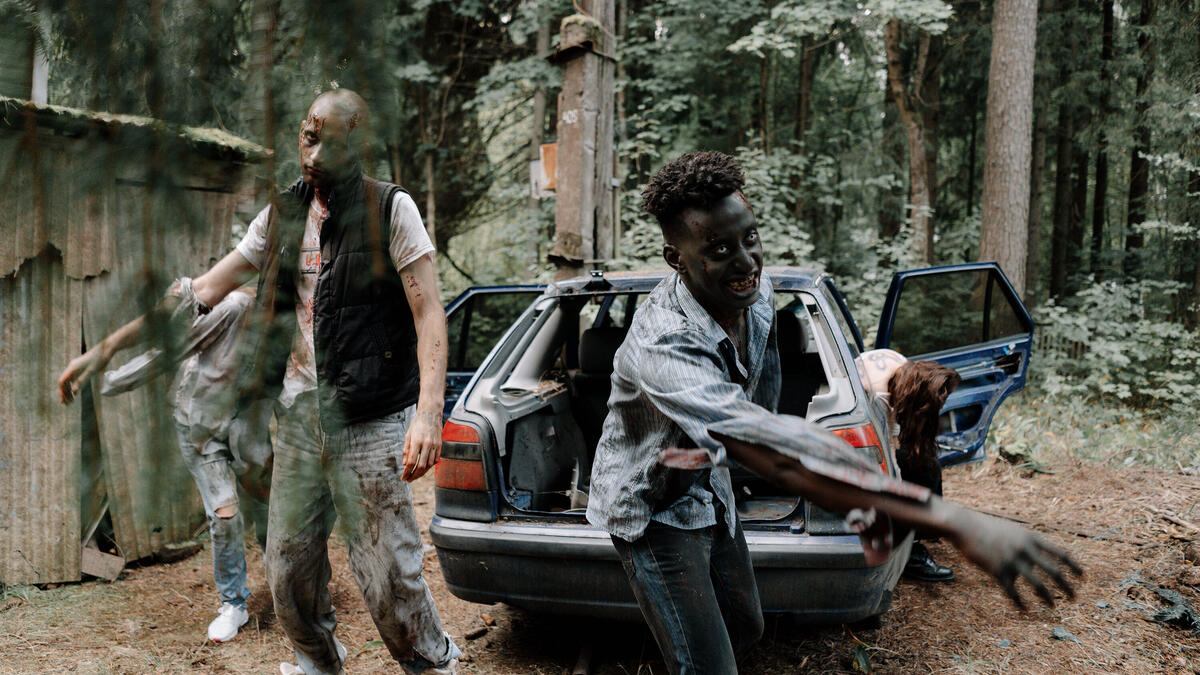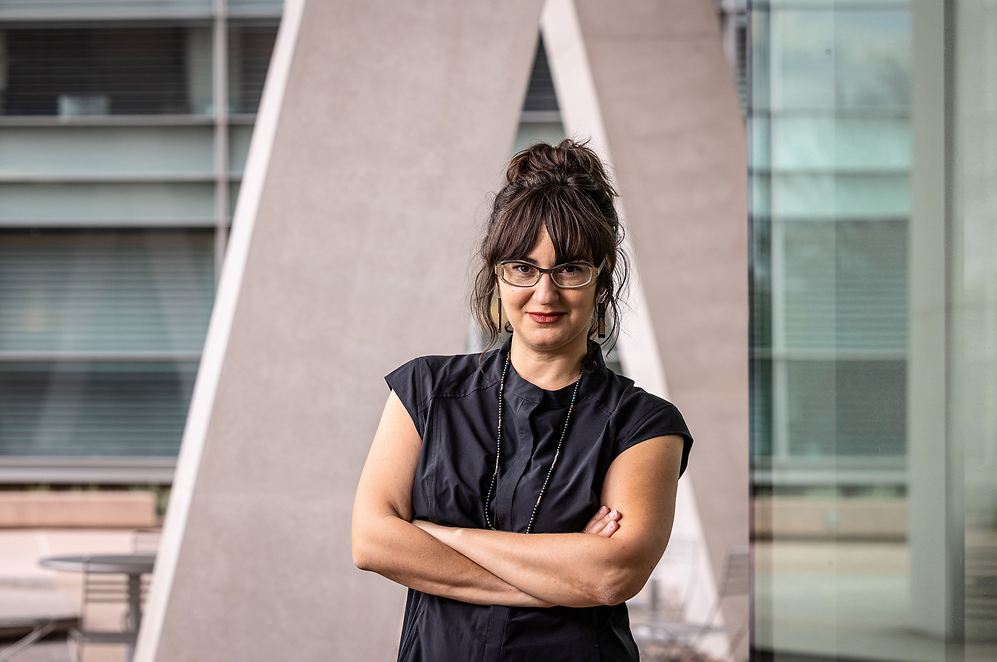It’s a busy time of year for zombies — horrifying haunted house-goers or neighbors on Halloween, as they hunt for brain food (or whatever else drops into their trick-or-treat bag).
These creepy corpses have also become a common narrative in movies, books, TV shows and video games, terrifying their targets as they track them down.
But Arizona State University Associate Professor of psychology Athena Aktipis says that zombie apocalyptic-related stories can do more than create nail-biting, terror-inducing or even entertaining experiences.
In an article titled “The Evolutionary Reasons We Are Drawn to Horror Movies and Haunted Houses” for the November issue of Scientific American, she explains how curiosity about these narratives can actually help people overcome fears and teach the collective community to handle everything from natural disasters and pandemics to the apocalypse.
“A lot of horror movies paint a picture of things happening in the real world that are really compelling and interesting and help us explore how we would react in those situations,” said Aktipis, who is also the assistant director of research in ASU’s Julie Ann Wrigley Global Futures Laboratory.
Dubbed the “zombie professor,” Aktipis has a podcast titled “Zombified” and is chair of the Zombie Apocalypse Medicine Alliance, which describes itself as “a respectful environment for humans, zombies and all other monsters.” She is also the director of the The Cooperation Lab, where studies of the role of microbes in human behavior and the nature of microbe-host interactions take place.
Aktipis was recently awarded $1.5 million by the National Science Foundation to tackle society’s inability to manage risk related to ecological changes and natural disasters. She and her team will design narratives and video games that use play-based platforms to help people establish survival techniques necessary for real-life disasters.
She spoke with ASU News about the life-saving possibilities of zombie narratives.
Editor's note: Answers have been lightly edited for length and clarity.
Athena Aktipis, ASU associate professor of psychology. Photo courtesy of ASU
Question: First off, how does someone in academia find themselves involved in zombie-related research?
Answer: At first, I became interested, not because of fictional zombies, but because of zombies that are actually real — biological zombies.
In my work, I deal with ants that get taken over by cordyceps fungus, rodents that get hijacked by toxoplasma gondii and dogs that get turned into zombie canines by the rabies virus. These are all examples of biological organisms where the parasite actually takes over the host and turns it into a vehicle for the survival and propagation of the parasite.
I also came to realize that most species on Earth are parasites — that zombification went beyond the biological world. There are lots of examples of zombification in our social and technological world as well. We allow many things to control us — to "zombify" us, if you will — relationships, our kids, our pets and social media, for example.
Some of these influences are good, and some aren't. But thinking about all of these kinds of influences through the lens of zombies is a great way to discover new things about the mechanisms and processes underlying zombification across all these systems. In fact, I teach a class on this very topic, called “The Science of Zombification.” It's really fun to teach.
Q: Your article explores the public’s fascination with horror movies, haunted houses, zombies and even crime shows, which in some sense seems as troubling as the horror itself. Why are people drawn to disturbing and upsetting experiences?
A: The immediate appeal is curiosity — morbid curiosity about things that are potentially threatening but in a fake or fun way.
And then, there is the evolutionary aspect. We might not realize it but, evolutionarily speaking, this is what scary play is all about. Our morbid curiosity about things that could harm us is, kind of ironically, a survival strategy. Other animals do it too. It’s called predator inspection — where prey actually go up to predators to learn about them. It’s something that happens with many different animals.
Q: How can these experiences be helpful?
A: Many people actually get a lot out of engaging in scary play. They learn about themselves, they learn about how they respond to scary situations and sometimes they also learn about threats in the world.
For example, horror fans and people who are more morbidly curious were actually more psychologically resilient during the COVID-19 pandemic.
There is a video game called "Mindlight," where players become characters that have to navigate through a scary house using a biofeedback interface that actually helps them learn how to regulate their anxiety during play. Studies show that this is actually as effective as cognitive behavioral therapy for helping kids deal with anxiety. And as you can imagine, they have a lot of fun with it.
Q: Can you explain how zombie apocalypse-related stories (movies, books, video games) that are engaged in by a group can teach society about surviving the apocalypse?
A: Well, research on this is still in progress, but we have seen through events, workshops and lots of conversations on the “Zombified” podcast that the zombie apocalypse is a great tool for getting people on the same page for solving problems and thinking through complex scenarios.
Zombie apocalypse stories can create fun and playful scenarios that allow people to think through how they might survive a real disaster, playing it through in their minds. It also can allow groups of people to figure out how to thrive when there might be challenges in terms of resource availability, infrastructure and social cohesion — as many zombie apocalypse movies portray.
Q: As chair of the Zombie Apocalypse Medicine Alliance, you are one of many who are “deadly serious” about researching zombies. What is this group all about?
A: It’s an unbelievable interdisciplinary group — we have doctors, policymakers, scientists, artists and humanities schools — and we all share this passion for using zombies and the zombie apocalypse to engage in things that are going on in our world that are frightening and try to make them fun.
It also creates a shared language among different academic disciplines. There are a lot of barriers to communication, but if we talk about the challenges we are facing in terms of zombies and the zombie apocalypse, it’s a playful framework to discuss things that are fundamentally very scary.
Top photo courtesy of Pexels
More Science and technology
2 ASU faculty elected as fellows to National Academy of Inventors
Arizona State University faculty members Bertram Jacobs and Klaus Lackner have been elected as fellows to the National Academy of Inventors (NAI). Both are being honored for research that…

Harvesting satellite insights for Maui County farmers
Food sovereignty can refer to having access to culturally significant foods, but Noa Kekuewa Lincoln believes it goes farther than that.“I think the concept goes beyond the foods themselves to having…

Google grant creates AI research paths for underserved students
Top tech companies like Google say they are eager to encourage women and members of historically underrepresented groups to consider careers in computer science research.The dawn of the era of…

